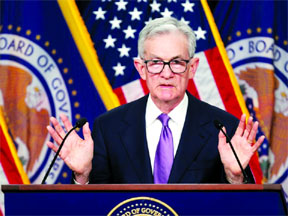WASHINGTON (TIP)- The Federal Reserve on Wednesday, December 18, lowered its key interest rate by a quarter percentage point, the third consecutive reduction and one that came with a cautionary tone about additional cuts in coming years. In a move widely anticipated by markets, the Federal Open Market Committee cut its overnight borrowing rate to a target range of 4.25%-4.5%, back to the level where it was in December 2022 when rates were on the move higher. Though there was little intrigue over the decision itself, the main question had been over what the Fed would signal about its future intentions as inflation holds steadily above target and economic growth is fairly solid, conditions that don’t normally coincide with policy easing.
In delivering the 25 basis point cut, the Fed indicated that it probably would only lower twice more in 2025, according to the closely watched “dot plot” matrix of individual members’ future rate expectations. The two cuts indicated slice in half the committee’s intentions when the plot was last updated in September. Assuming quarter-point increments, officials indicated two more reductions in 2026 and another in 2027. Over the longer term, the committee sees the “neutral” funds rate at 3%, 0.1 percentage point higher than the September update as the level has drifted gradually higher this year.
“With today’s action, we have lowered our policy rate by a full percentage point from its peak, and our policy stance is now significantly less restrictive,” Chair Jerome Powell said at his post-meeting news conference. “We can therefore be more cautious as we consider further adjustments to our policy rate.”
“Today was a closer call but we decided it was the right call,” he added.
Stocks sold off sharply following the Fed announcement, with the Dow Jones Industrial Average closing down more than 1,100 points while Treasury yields soared. Futures pricing pared back the outlook for cuts in 2025, according to the CME Group’s FedWatch measure.
“We moved pretty quickly to get to here, and I think going forward obviously we’re moving slower,” Powell said.
For the second consecutive meeting, one FOMC member dissented: Cleveland Fed President Beth Hammack wanted the Fed to maintain the previous rate. Governor Michelle Bowman voted no in November, the first time a governor voted against a rate decision since 2005.
The fed funds rate sets what banks charge each other for overnight lending but also influences a variety of consumer debt such as auto loans, credit cards and mortgages.
The post-meeting statement changed little except for a tweak regarding the “extent and timing” of further rate changes, a slight language shift from the November meeting. Goldman Sachs said the adjustment was “hinting at a slower pace of rate cuts ahead.”
The cut came even though the committee jacked up its projection for full-year 2024 gross domestic product growth to 2.5%, half a percentage point higher than September. However, in the ensuing years the officials expect GDP to slow down to its long-term projection of 1.8%.
Other changes to the Summary of Economic Projections saw the committee lower its expected unemployment rate this year to 4.2%, while headline and core inflation according to the Fed’s preferred gauge were pushed higher to respective estimates of 2.4% and 2.8%, slightly higher than the September estimate and above the Fed’s 2% goal.
